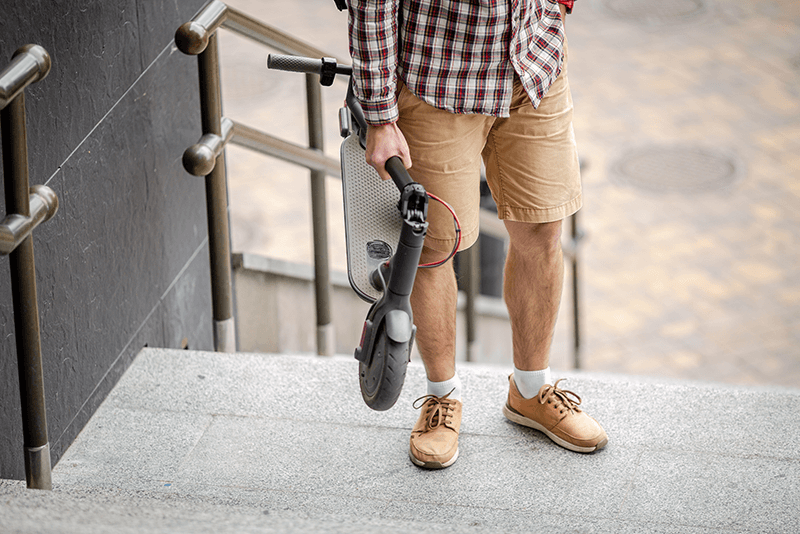
In February, the Department for Transport published new guidance relating to the e-cycle and e-scooter battery risk for premises in England, Scotland, and Wales.
It contains key guidance and resources for premises owners on how to mitigate the risks of lithium-ion battery products.
Please note, that it is not a legal document and does not replace any existing regulations.
Context of the guidance
The guidance acknowledges the importance of e-cycles and e-scooters in the government’s aim for decarbonisation in the transport sector.
It also references evidence that the e-scooters can provide people with access to more transport options. With people from low-income and minority groups able to use rental services.
The guidance also highlights the physical and mental health benefits of using e-bikes and e-scooters.
However, the guidance reports that lithium battery fires involving e-scooters and e-cycles are increasing year-on-year. There are also a number of fatalities and serious injuries reported each year.
Data collated from 38 FRSs suggests that the total incidents in recent years have been at least:
2020: 77
2021: 159
2022: 227
2023: 338 (forecast)
This data also reports that:
- The risk is highest whilst charging
- Established products used in line with the manufacturer’s instructions present a lower fire risk
- ‘Gig economy’ delivery drivers are a high-risk user group
- Visibly damaged, bulging, malodorous, or leaking battery packs pose an extremely high risk
The guidance does preface the following information with the reminder that all premises managers should consult a competent fire risk assessor for advice relating to lithium fires and any specific relating to the devices in their workplace.
It also adds a reminder that a fire risk assessment and any mitigation measures related to it are a legal duty under the Regulatory Reform (Fire Safety) Order 2005.
The introduction of a new hazard such as e-bikes or e-scooters would require a review of the fire risk assessment.
Key points of the battery risk for premises guidance
The government guidance suggests the following steps for mitigating the e-scooter and e-bike battery risk for premises:
Educating users to promote responsible use and purchase
Passing on this guidance to premises users and initiating learning for users on how to safely charge and store their devices will raise awareness and promote better practices.
Premises owners or managers should make it clear that any damaged lithium batteries should not be brought onto the premises as they present a significant fire risk.
It is also recommended to seek guidance from local fire and rescue services that may have developed guidance for specific local conditions.
It is important to remain up to date with guidance to implement safety measures and keep users as safe as possible.
Providing facilities at the premises to facilitate safe charging and use
Providing safe and secure battery storage and charging facilities, ideally located outside, on the ground level and purpose-designed, will give premises users a place to safely charge their devices without the worry of theft or damage. These facilities can be for the whole bike or scooter, or just for the batteries themselves.
The number of charging outlets should be considered so that even at maximum capacity, no one should need to use extension leads or adapters.
Upgrading or relocating any existing cycle storage areas for enhanced fire safety is a priority, as well as ensuring that it is accessible, easy to use, and secure so that people are less likely to store their e-cycles within the building.
Management of the premises to address the remaining risks
Adding an alarm system, or a means of raising the alarm, to alert all building residents in the event of fire should be in place throughout the building.
An external isolation system should also be put in place to cut the power to any storage or charging facility for use in an emergency.
The implications of possible high temperatures on the building structure and any cladding should be considered in the location of the charging station, as should any additional issues such as the location of gas intake pipes (this should be advised by a fire risk assessor).
Lithium-ion battery fires often require a large amount of water so the run-off of water and any contaminated water should be considered too.
Policies restricting the charging and storage of e-bikes, e-scooters, and similar items in common areas, stairwells, and other fire escape routes should be fully implemented, communicated, and monitored.
It would also be worthwhile for premises that do not involve overnight stays, such as offices, to consider a restriction on charging batteries on the premises.
Useful resources
The following resources relate directly to the battery risk for premises and guidance to help or can be applied.
In September 2023, London Fire Brigade released Fire Safety Guidance Note GN103: charging and storage for electric-powered personal vehicles, providing detailed guidance for office premises up to 18 metres.
Both local transport note (LTN) 1/20 and the BA/CRWG UK public cycle parking standard focus on public parking but a lot of the information is also relevant to private sector cycle parking provision.
Fire safety: guidance for those with legal duties – is a collection of documents on fire safety law and guidance for those who have a legal duty for fire safety in a relevant building to help them meet those duties.
The insurance industry also publishes fire risk management guidance which premises managers should check. At the time of writing, there is no document specific to e-scooter or e-cycle fire risk, though.
The following guidance from the Department for Transport (DfT) covers a range of topics:
- Gear Change: policy paper outlining the role of cycles and e-cycles in England’s future transport policy
- Electrically assisted pedal cycles (EAPCs) in Great Britain: information sheet
- Guidance on powered transporters, which includes privately owned e-scooters
- E-scooter trials: guidance for local authorities and rental operators
- E-scooter trials: guidance for users
You can find out more about lithium-ion batteries here.
There is a useful CPD course from the Firechief® Academy on lithium-ion batteries here.


Disclaimer
The Firechief® range includes high-performance fire extinguishers, fire blankets, first aid kits, lithium-ion fire extinguishers and the Kitchen Stove Guard. For more information, call us on +44 (0)330 999 0019 or email sales@firechiefglobal.com.
This blog is provided solely for general informational and educational purposes, not intended as a substitute for professional advice. Before taking any actions based upon this information, we advise to consult any and all relevant statutory or regulatory guidance. Where necessary consult a qualified fire or industry regulation professional. The use or reliance on any information contained herein is solely at the reader's risk.

